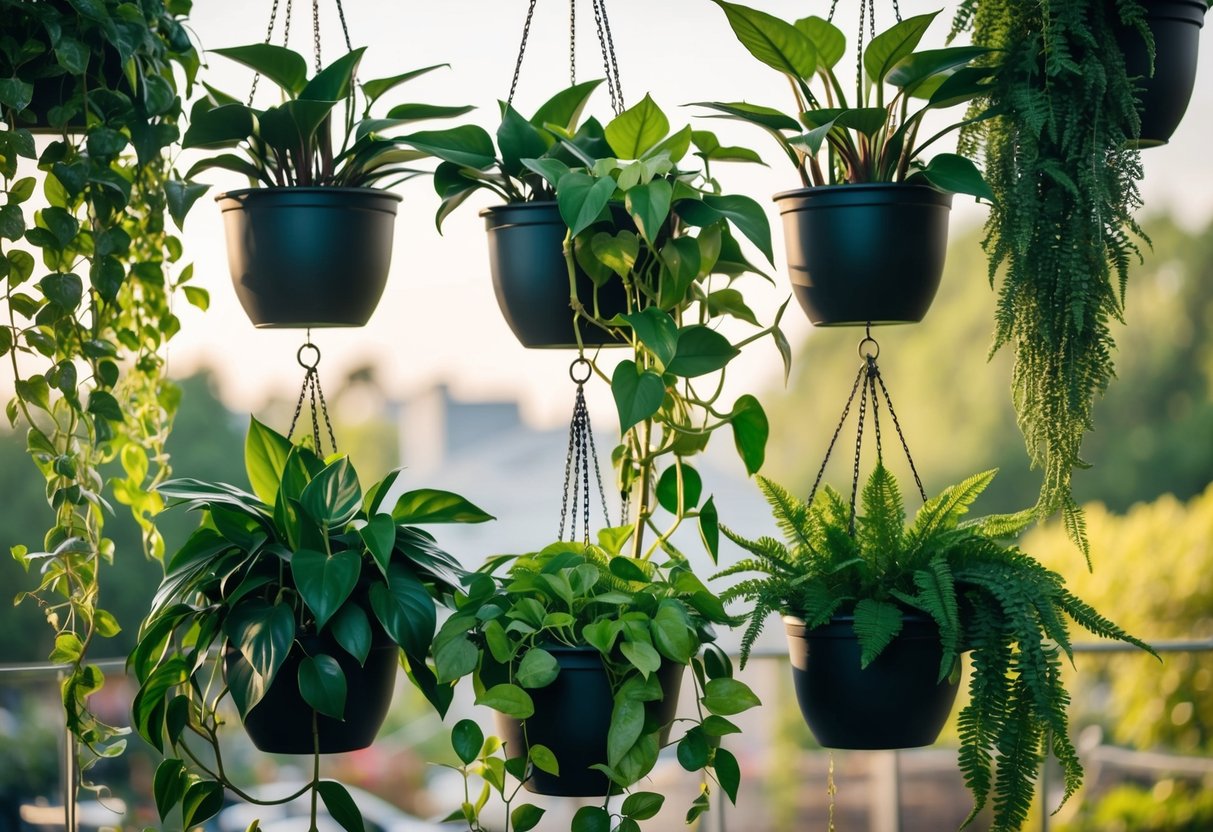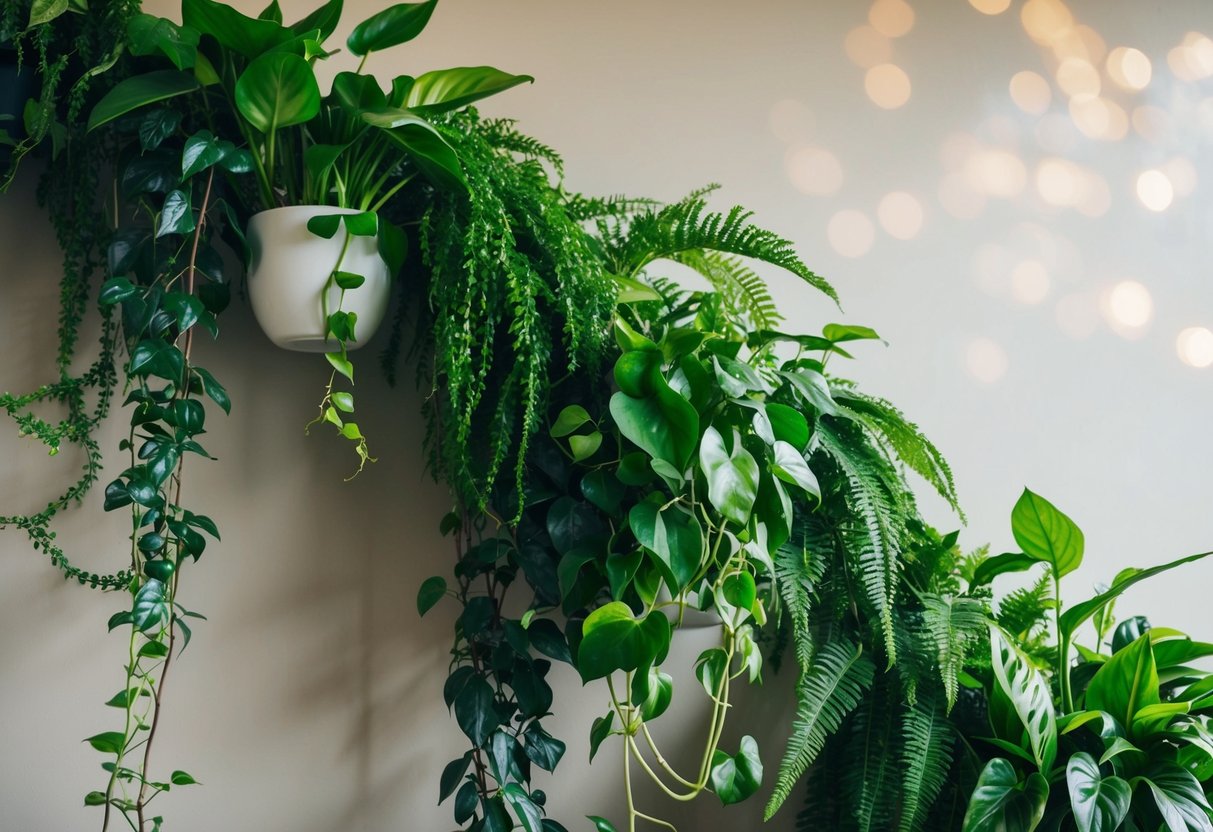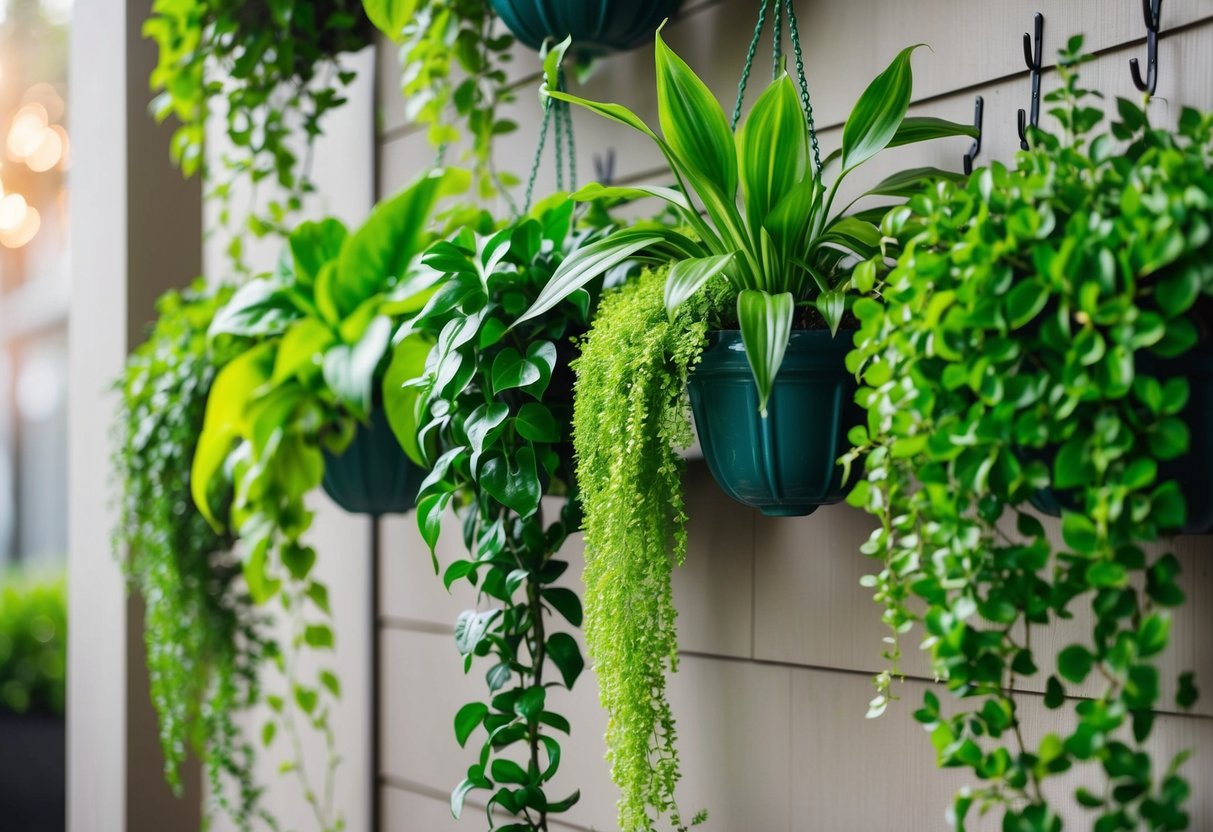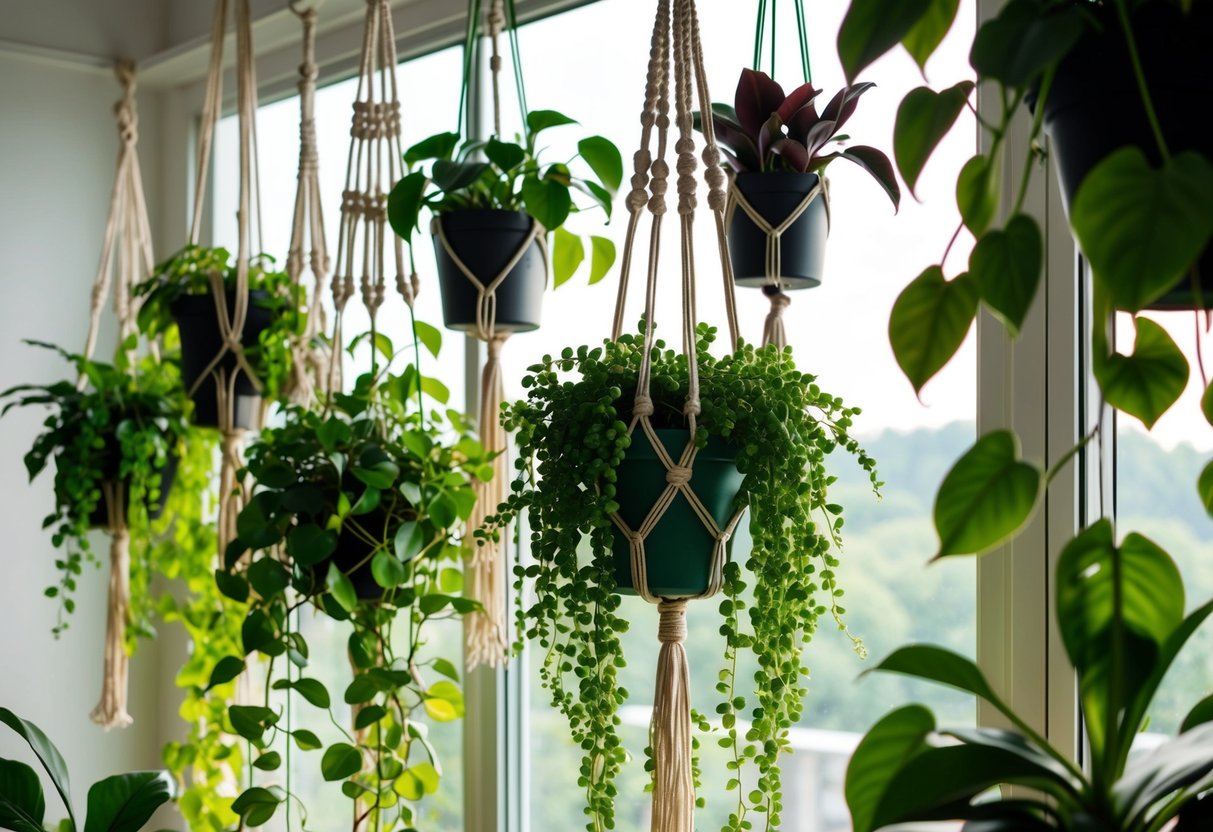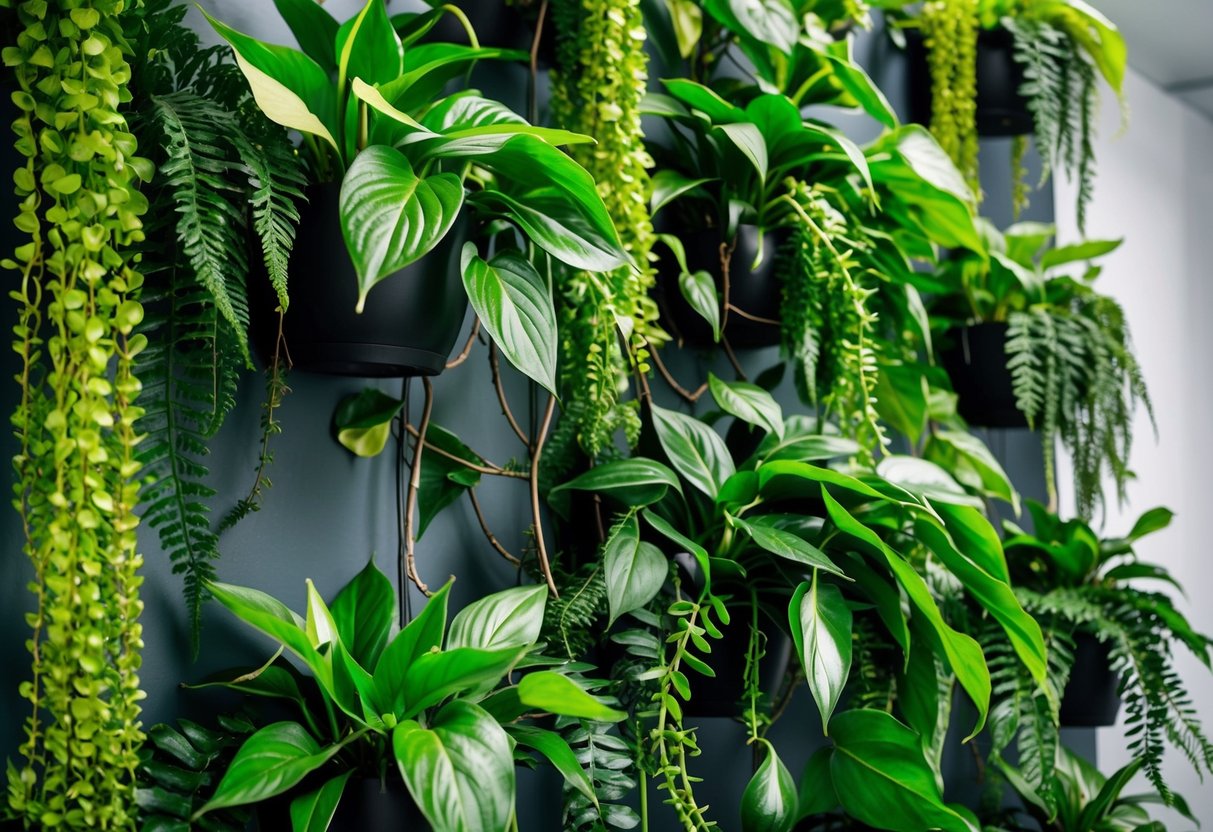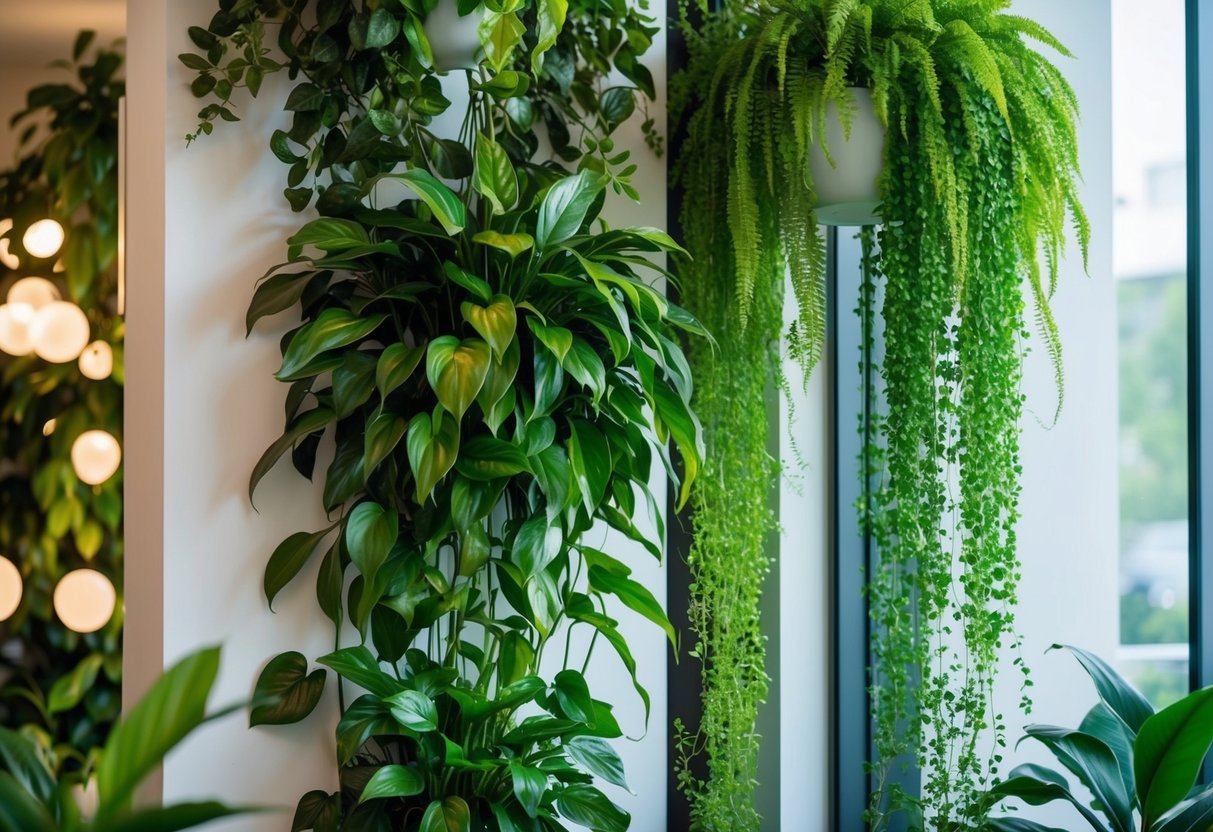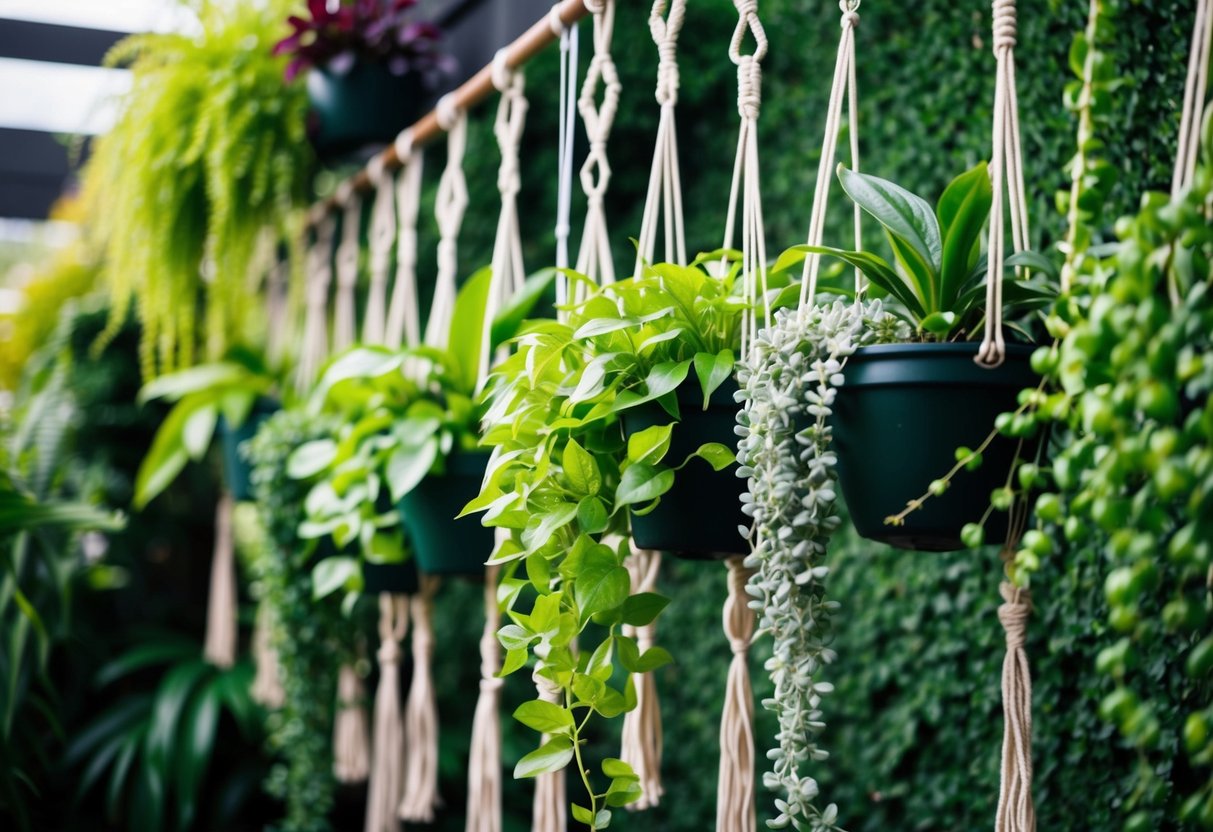HousePlantJoy is supported by our audience. When you purchase through one of our links, we may earn a small affiliate commission. As an Amazon Associate I earn from qualifying purchases. Your cost is not affected.
==================
Best Hanging Plants for Vertical Greenery: Easy-Care Beauties to Transform Your Space
Looking to add some life to your vertical space? I love how hanging plants can transform any room into a lush, green paradise without taking up precious floor space. Spider plants, pothos, and string of pearls are perfect choices for creating stunning vertical gardens, as they’re easy to care for and adapt well to various light conditions.
I’ve discovered that hanging plants like pothos come in beautiful varieties with different leaf patterns and colors. My favorite is the Marble Queen pothos, with its striking white and green variegated leaves that cascade down gracefully from hanging baskets.
Living in a small apartment myself, I’ve found that vertical gardening saves valuable space while bringing nature indoors. These plants not only beautify my home but also clean the air and create a peaceful atmosphere.
Key Takeaways
- Hanging plants maximize vertical space while creating a living green wall effect
- Easy-care varieties like pothos and spider plants thrive in most indoor environments
- Indoor hanging gardens improve air quality and create a calming atmosphere at home
Getting Started with Hanging Plants
I love how hanging plants can transform any space into a green oasis! Let me share my top tips for success with these beautiful trailing beauties.
Choosing the Right Plants for Your Space
Pothos and spider plants make excellent starter plants since they’re super forgiving and adaptable. I’ve found these plants thrive in most indoor conditions.
When picking your first hanging plant, start with just 1-2 varieties. This lets you learn their specific needs without getting overwhelmed.
Look for healthy plants with:
- Vibrant green leaves
- No brown spots or yellowing
- Full, bushy growth
- Strong stems
- No signs of pests
Understanding Light Requirements
Most indoor hanging plants need bright, indirect light to thrive. I place mine near east or north-facing windows for perfect lighting conditions.
Watch for these signs of lighting issues:
- Yellowing leaves = too much light
- Leggy growth = not enough light
- Small leaves = insufficient light
- Burnt patches = direct sun exposure
Move plants around until you find their sweet spot. Each location in your home offers different light levels.
Importance of Proper Watering
I check moisture levels by sticking my finger about an inch into the soil. If it feels dry, it’s time to water!
Three key watering tips:
- Never let plants sit in standing water
- Water thoroughly until it drains from bottom
- Adjust frequency based on season
During winter, I water less frequently since plants grow slower. In summer, they might need water twice a week.
The Basics of Plant Nutrition
I feed my hanging plants with balanced liquid fertilizer (10-10-10) during the growing season.
Fertilizing schedule:
- Spring/Summer: Every 2-4 weeks
- Fall/Winter: Every 6-8 weeks
- Skip fertilizing when plants are stressed
Watch leaf color – if they’re pale green, they might need more nutrients. Dark green, healthy leaves mean your feeding schedule is perfect!
Top Hanging Plant Varieties
Indoor hanging plants bring life and beauty to any space. I love how they transform empty corners and create stunning vertical displays that catch everyone’s eye.
Pothos: An Easy and Versatile Choice
Golden pothos is my absolute favorite hanging plant. Its heart-shaped leaves come in gorgeous varieties like ‘Marble Queen’ with white variegation and ‘Neon’ with bright chartreuse foliage.
I’ve found pothos to be super adaptable. They grow happily in bright indirect light or partial shade, making them perfect for most rooms.
These vines are nearly impossible to kill! They only need water when the top inch of soil feels dry. I trim mine occasionally to keep them full and bushy.
The vines can trail up to 10 feet long, creating a dramatic cascade of greenery. They also help clean indoor air, which is an awesome bonus.
Ferns: Lush and Leafy Options
Bird’s nest ferns have unique wavy leaves that add tropical flair. I keep mine in a bathroom where they love the extra humidity.
Staghorn ferns make a bold statement with their large antler-like fronds. They prefer bright indirect light and weekly misting to thrive.
Boston ferns are classic beauties with delicate arching fronds. I’ve learned they need consistent moisture and humidity to stay lush and green.
Spider Plant
Spider plants are such fun, playful plants! Their long striped leaves arch gracefully, and they produce adorable baby plants on long stems.
These tough plants adapt to most light conditions. I love how fast they grow and how easy they are to propagate from the babies.
They’re pet-safe too, which makes them perfect for homes with curious cats or dogs.
Geraniums
Hanging geraniums bring cheerful blooms in pink, red, or white. I plant them in south-facing windows where they get plenty of sun.
These flowering beauties need well-draining soil and regular deadheading to keep blooming. I fertilize mine every two weeks during the growing season.
They’re drought-tolerant and bounce back quickly if I forget to water them.
Begonia
Angel wing begonias have beautiful spotted leaves and delicate flowers. They thrive in bright indirect light but need protection from harsh afternoon sun.
I keep the soil consistently moist but not soggy. Their stems can become quite woody over time, creating an interesting structural element.
The flowers bloom in cycles throughout the year, adding pops of color to my indoor garden.
String of Pearls
This unique trailing plant looks like strands of green beads cascading from the pot. The tiny round leaves store water, making it drought-tolerant.
I give mine bright indirect light and let the soil dry between waterings. The stems can grow several feet long, creating a living curtain effect.
Be careful with pets though – these plants are toxic if eaten.
Philodendrons: Heart-Shaped Beauty
Heartleaf philodendrons have glossy green leaves that shimmer in the light. Their vines grow quickly and can be trained to climb or trail.
I’ve found they’re super forgiving of low light conditions. They tell me when they need water by slightly drooping their leaves.
These plants are perfect for beginners since they’re so easy to care for and propagate.
Unique and Quirky Plants
Swiss cheese vine has fascinating perforated leaves that create interesting shadows. They love climbing but look equally stunning in hanging baskets.
Lipstick plants surprise me with bright red flowers that peek out like tubes of lipstick. They prefer humid conditions and regular feeding during the growing season.
String of turtles has tiny leaves that look like little turtle shells. I keep mine in a bright spot but protected from direct sun.
Care and Maintenance Tips
Keeping your hanging plants healthy and thriving takes a mix of regular attention and smart preventive measures. I’ve learned that a few simple habits can make all the difference in creating stunning vertical displays.
Pruning for Health and Aesthetics
I always start my pruning sessions by removing any yellow or brown leaves – they’re just using up the plant’s energy! For pothos and other trailing plants, I trim just above a leaf node to encourage bushier growth.
I make my cuts at a 45-degree angle with clean, sharp scissors to prevent damage and disease spread. This angle helps water roll off instead of sitting on the cut end.
Pro tip: I save healthy cuttings for propagation! They make great gifts or let me fill out sparse areas in the same plant.
Preventing and Treating Root Rot
Root rot is super sneaky – by the time you see droopy leaves, it’s often advanced. I check my plants’ roots every few months by gently removing them from their pots.
Healthy roots should be firm and white or light tan. If I spot any mushy, brown, or smelly roots, I trim them off right away with clean scissors.
The best prevention is using well-draining soil with perlite and bark. I mix my own using:
- 4 parts coco coir
- 2 parts perlite
- 1 part orchid bark
- 1 part sand
Optimizing Humidity Levels
Most hanging plants love humidity! I keep a humidity tray filled with pebbles and water under my ferns and tropical beauties.
I mist my plants in the morning so the leaves can dry before night. But be careful – constant wet leaves can invite fungal problems.
My favorite humidity-boosting tricks:
- Group plants together to create a mini moisture zone
- Run a small humidifier nearby
- Place plants in naturally humid rooms like bathrooms
The Role of Drainage in Plant Health
Every hanging pot needs drainage holes – no exceptions! I drill extra holes if needed using a masonry bit.
I always check that water flows freely through the pot before planting. A layer of pebbles or broken pottery at the bottom helps prevent soil from clogging the holes.
Between waterings, I let the top inch of soil dry out. This encourages roots to grow deeper and stronger.
Pest Prevention Strategies
I inspect my plants weekly for tiny pests and webbing. A magnifying glass helps spot problems early!
My natural pest control arsenal includes:
- Neem oil spray
- Insecticidal soap
- Sticky traps
- Regular leaf cleaning with damp cloth
Good air circulation is key to pest prevention. I space my plants so leaves don’t touch and trim crowded areas to improve airflow.
Designing Your Vertical Greenery
Adding hanging plants to your walls and ceilings brings life and beauty to unused spaces. I love how vertical gardens can transform empty corners into lush, green sanctuaries.
Creating Visual Interest with Trailing Vines
Trailing plants like ivy and pothos create stunning cascading effects that catch the eye. I recommend varying the lengths of your trailing vines by hanging some plants higher and others lower.
Mix different leaf shapes and textures to add depth. Try pairing large-leafed pothos with delicate string of pearls for contrast.
Group plants in odd numbers – I find that clusters of 3 or 5 hanging plants look more natural and appealing than even numbers.
Maximizing Use of Vertical Space
Empty walls and corners are perfect spots for hanging baskets and vertical planters. Install sturdy hooks at different heights to create layers of greenery.
Think beyond basic hanging baskets! I love using:
- Wall-mounted plant holders
- Macramé hangers
- Tiered plant stands
- Tension rods between walls
- Window-mounted shelves
Leave enough space between plants so they can grow without crowding each other. Most trailing vines need 2-3 feet of vertical space to cascade beautifully.
Incorporating Plants into Your Decor
Match your planters and hangers to your existing decor style. I like using ceramic pots in neutral colors for modern spaces and woven baskets for a bohemian feel.
Frame doorways and windows with hanging plants to create natural curtains of greenery. Spider plants and ferns work great here since they don’t grow too wild.
Consider light levels when placing plants:
- Bright indirect light: Spider plants, pothos
- Medium light: Heart-leaf philodendron
- Lower light: Various ferns
Group plants with similar water needs together to make maintenance easier. I always keep moisture-loving ferns separate from drought-tolerant succulents.
Health Benefits of Indoor Plants
Indoor plants make my home healthier by cleaning the air and adding a natural boost to my living spaces. I’ve discovered that certain hanging plants work like natural air filters.
Air Purifying Qualities of Plants
Snake plants, spider plants, and peace lilies are my top picks for boosting oxygen levels in rooms. These green friends work overtime while I sleep, converting carbon dioxide into fresh oxygen.
I love how my pothos plants remove formaldehyde from the air. They’re excellent air-cleaning champions that look beautiful trailing from hanging baskets.
Spider plants are my favorite air-purifying powerhouses. I’ve noticed they’re super easy to grow and they produce lots of baby plants that clean even more air.
Reducing Indoor Pollutants
My indoor plants act like natural filters against common household toxins. They trap and absorb harmful substances that float around in my home.
I keep English ivy in my bathroom because it helps remove airborne particles. It’s amazing how these leafy friends can catch dust and other tiny particles that would otherwise end up in my lungs.
The best part? These plants work 24/7 to clean my air without using any electricity. I’ve placed them strategically near potential pollution sources like printers and cleaning supply storage areas.
Advanced Plant Care Techniques
Taking your hanging plants to the next level requires some specialized knowledge and a bit of practice. I’ve learned these techniques through years of experience, and they’ll help your plants thrive.
The Art of Propagation
I love creating new plants from my existing collection! For pothos plants, I cut a stem just below a node, making sure to include 2-3 leaves.
I place the cutting in water and watch the magic happen within 2-3 weeks as new roots emerge. The water should be changed weekly to keep it fresh.
Pro tip: Clear containers work best since I can easily monitor root development. I’ve found that adding a tiny bit of liquid fertilizer to the water speeds up root growth.
Mastering the Science of Soil Mixtures
The perfect soil mix makes a huge difference in plant health. I create my custom blend using:
- 2 parts regular potting soil
- 1 part perlite
- 1 part orchid bark
- 1/2 part activated charcoal
This mixture provides the well-drained soil that hanging plants need. I make sure to mix all components thoroughly before potting.
Root rot is a thing of the past since I started using this mix. When repotting, I gently break up the old soil and trim any dead roots before placing the plant in fresh soil.
Celebrating the Joy of Indoor Gardens
Creating a vertical garden brings life and energy into my home. My hanging plants transform plain walls into magical green spaces that lift my mood every day.
Showcasing Creative Plant Arrangements
I love mixing different textures and colors in my indoor hanging plants. My favorite combo includes the dramatic leaves of Swiss cheese vine paired with cascading pothos varieties like ‘Marble Queen’ and ‘Neon’.
I use macramé hangers at varying heights to create visual interest. Some plants dangle near eye level, while others float closer to the ceiling.
Empty corners become stunning focal points when I cluster 3-4 hanging baskets together. I especially love using:
- Round woven baskets
- Clear glass terrariums
- Colorful ceramic pots
Sharing Your Green Space with Friends and Family
My indoor garden has become the perfect gathering spot. Friends always comment on my thriving vertical garden during coffee dates.
I start new plants from cuttings to share with visitors. Teaching someone how to propagate their first pothos brings me so much joy.
My kids help with weekly plant care too. They’ve named each plant and love checking for new growth. This green oasis has truly become our family’s happy place.
Frequently Asked Questions
Let me share my tried-and-true tips for picking and caring for hanging plants, whether you’re a busy plant parent or working with tricky lighting conditions.
What’s the easiest hanging plant to care for if you’re a bit forgetful?
I always recommend pothos as the perfect low-maintenance hanging plant. These hardy plants can bounce back even if you forget to water them for a while.
They’ll actually tell you when they need water by drooping their leaves a bit – it’s like they’re waving at you for attention!
Can you hang a Pothos beside a Spider Plant without them bickering?
These two are actually best friends in the plant world! Spider plants and pothos make excellent neighbors since they have similar care needs.
I’ve found they create a gorgeous layered look with the pothos’ heart-shaped leaves complementing the spider plant’s arching stems.
Which hanging plants thrive in the cozy corners with not much light?
Bird’s nest ferns and pothos are my go-to choices for dim spaces. They’re like the superheroes of shady spots!
Snake plants also do amazingly well in low light, though they’re not typically hanging plants, you can get creative with wall-mounted planters.
How do you create a lush green balcony with hanging plants?
I love mixing plants with different textures and trailing lengths. Try combining Swiss cheese vine with its unique holey leaves alongside cascading pothos.
Add some English ivy for that classic trailing look, and maybe a few spider plants to create some height variation.
What are the hardiest outdoor hanging plants that love full sun?
English ivy and spider plants are my top picks for sunny spots. They’re tough cookies that can handle direct sunlight like champs.
Just remember to water them more frequently since the sun will dry them out faster than their indoor cousins.
Got any tips for identifying hanging plants that look amazing together?
I love pairing plants with contrasting leaf shapes. Try matching the heart-shaped leaves of pothos with the spiky drama of spider plants.
Mixing ferns with trailing vines creates a stunning vertical display that plays with different textures and shades of green.

